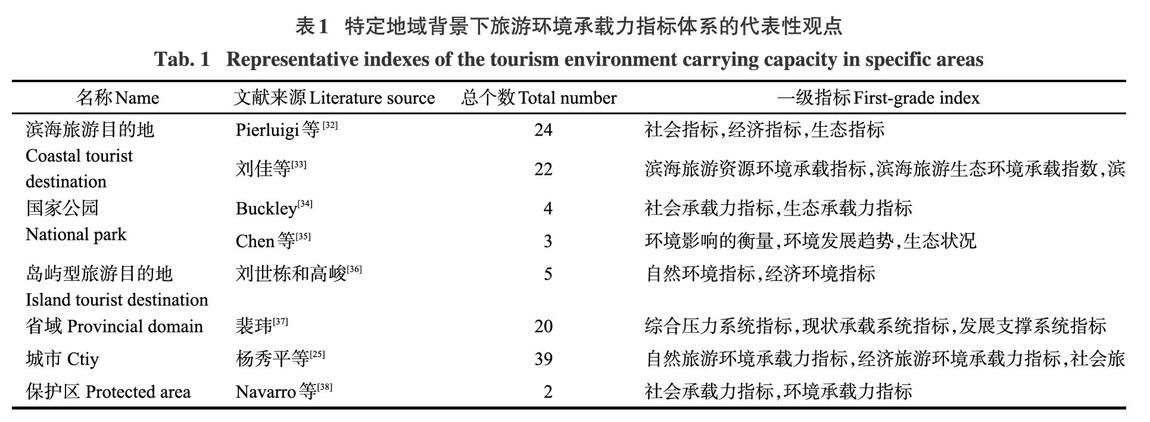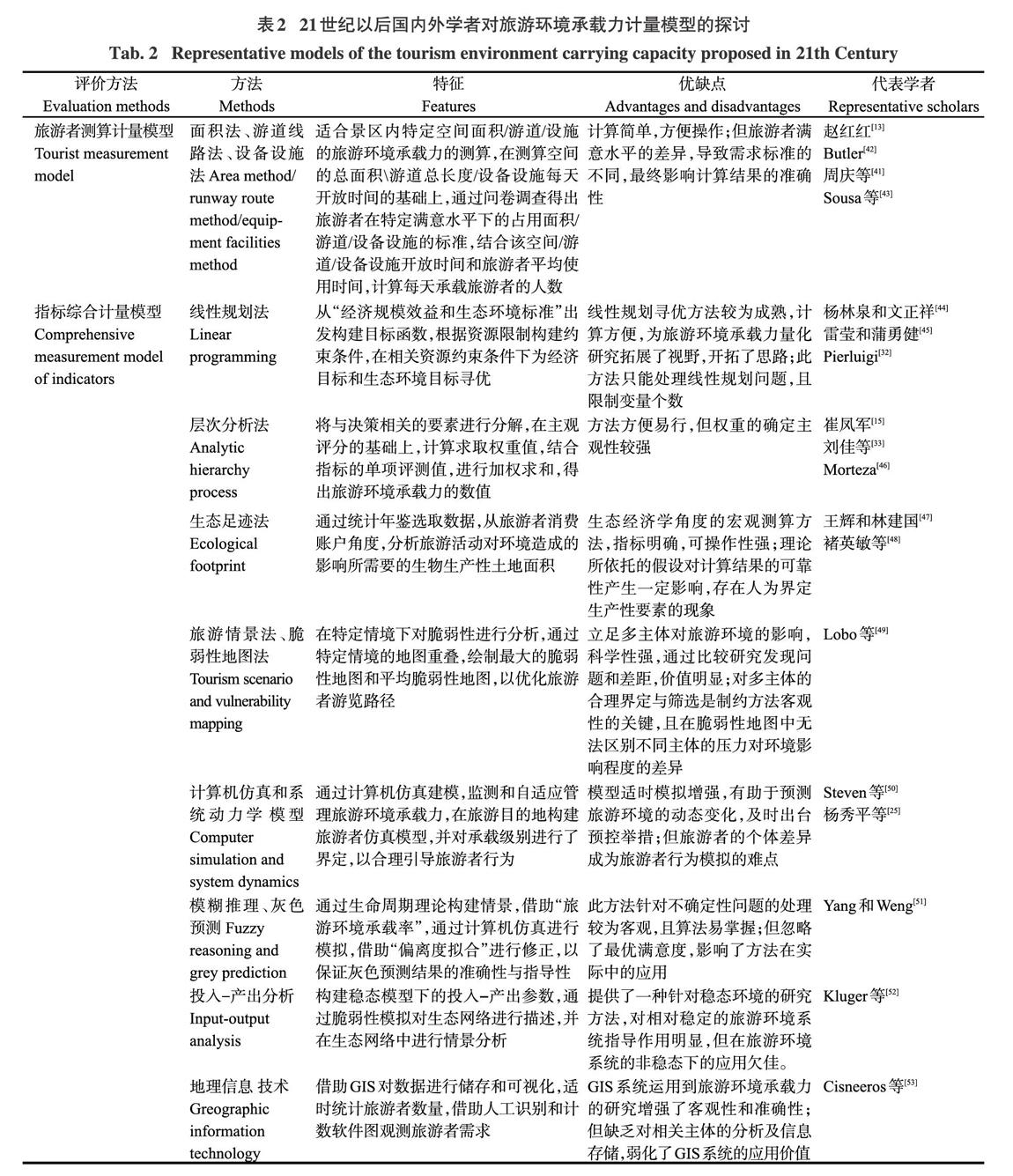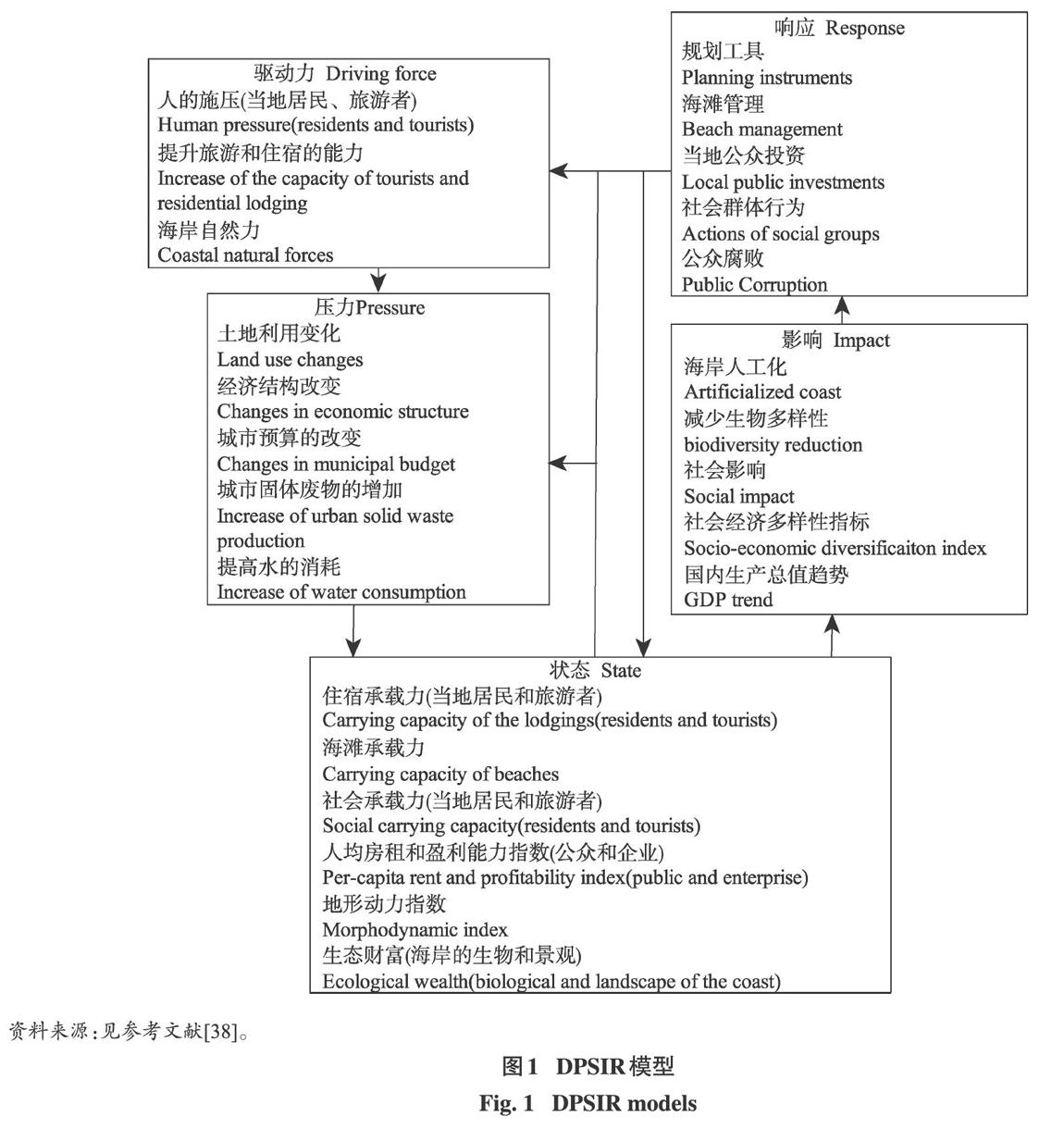旅游環境承載力研究綜述
楊秀平 翁鋼民



[摘 要]旅游環境承載力的研究對加強旅游目的地的管理、提升目的地相關主體的滿意度、促進目的地可持續發展具有重要意義,旅游環境承載力問題的研究成為旅游管理領域的研究熱點。文章從旅游環境承載力的概念、指標體系、計量模型、應用研究和管理工具等5個方面梳理了近年來國內外學者的研究,提出旅游環境承載力問題的研究方向和側重點,指出:(1)針對旅游相關主體偏好的區間性特征、界定基于多主體需求的旅游環境承載力概念體系,從旅游環境承載力的供給指標與主體對旅游環境的需求要素角度構建指標體系;(2)提高旅游環境承載力計量模型的科學性與精確性,分析系統內部與系統之間的動態匹配機理、測度模型,模擬特定主體的行動軌跡與旅游環境承載力的波動軌跡;(3)結合時代特征,關注典型區域,并展開應用研究;(4)對旅游環境可持續承載進行優化,分析可持續承載“潛力”轉化為可持續承載“實力”的系統性管理舉措。
[關鍵詞】旅游環境承載力;旅游可持續發展;人一地關系;旅游影響
[中圖分類號]F59
[文獻標識碼]A
[文章編號]1002-5006(2019)04-0096-10
Doi: 10.19765/j .cnki.1002-5006.2019.04.013
引 言
旅游承載力(tourism canying/bearing capacity)又被稱為旅游容量,當今國內外學者關于此問題的研究多集中在旅游環境承載力、旅游環境容量方面[1],相關文章多發表在旅游、生態、環境、地理等主題的學術期刊,雖有學者質疑兩者的差異,但多數學者堅持旅游環境容量與旅游環境承載力是同義語。20世紀60年代,旅游環境承載力問題受到學者的關注;20世紀90年代后,隨著可持續發展理念研究的深入,旅游環境承載力相關問題逐漸成為旅游資源開發與規劃領域研究的熱點問題。旅游環境承載力相關問題的研究憑借其獨特的理論與廣闊的應用前景,闡釋著“人一地”系統的相互作用機制以及人類活動產生的生態與環境效益。
21世紀旅游發展迅猛,旅游產業已成為部分國家或地區國民經濟的戰略性支柱產業;旅游者規模空前增大,旅游活動成為百姓常態化的生活方式。根據《世界旅游經濟趨勢報告(2019)》的分析,2018年全年全球旅游總人次達121.0億人次,全球旅游總收入達5.34萬億美元,預計2019年全球旅游總收入將達到5.54萬億美元,相當于全球GDP的6%,高于全球經濟增長速度;從我國來看,2018年國內旅游為55.4億人次,中國公民出境旅游1.48億人次,入境游客1.42億人次,實現旅游收入約5.99萬億元,預計2019年國內旅游人數60.6億人次,將實現旅游總收入6.52萬億元①。大眾旅游時代的到來,旅
游者出游率的提升,導致旅游旺季客流的大規模集中,當外界“刺激”(旅游環境需求量)超出旅游環境承載力時,旅游環境系統將逐漸呈現逆向變化嘲。世界旅游組織指出,把旅游活動限定在旅游環境承載力范圍內,是保證旅游目的地可持續發展的需要。在此背景下,國內外學者對旅游環境承載力的相關問題進行著基礎性和前沿性研究、從事著本土化適應性的嘗試,以期對民眾出行進行合理引導。
近年來,旅游環境承載力相關問題的研究逐步深入,文章從旅游環境承載力的概念、指標體系、計量模型、應用研究與管理工具5個角度對旅游環境承載力相關研究進行梳理,提出今后旅游環境承載力研究的重點方向與研究內容,解決旅游發展中旅游者大量涌入導致旅游環境壓力增大的系列現實問題,為實現旅游目的地的可持續發展提供科學依據。
1 旅游環境承載力概念的研究
學者們對旅游環境承載力的探討圍繞“人一地”關系展開,以“地”為中心的理念認為旅游環境承載力的研究重點考慮人類開展旅游活動空間場所和地域背景下的基礎要素;以“人”為中心的理念認為旅游環境承載力的研究應關注以旅游者為代表的相關主體的感受。20世紀60-70年代,旅游環境承載力概念的探討側重于“使用量”[3]“利用強度”[4]與“旅游者滿意度”[5-6]等的定性分析;20世紀80-90年代以后,伴隨著國內學者對旅游環境承載力研究的起步,學者們在前期“使用量”“利用強度”[5,7-11]等相關研究的基礎上,熱衷于目的地旅游者數量極限值或臨界值的界定,旅游環境承載力研究的側重點集中在旅游者的“最大承載數量”[12-17],旅游環境承載力成為目的地旅游可持續發展的重要判據[15]。進入21世紀,旅游環境承載力的研究在強調其“增長極限——旅游者最大承載數量”[18-19]“使用水平與利用強度”[20-22]的同時,旅游環境相對承載力的研究有助于目的地旅游環境承載力問題的橫向比較[21];有學者提出在旅游發展中應注重多主體對旅游環境需求與目的地旅游吸引物承載力之間的匹配、考慮相關主體利益的協調[22-24],部分學者把旅游影響研究納入旅游環境承載力的研究范疇[25-26],旅游環境可持續承載問題的研究體現了國內外學者對旅游社會責任的認同[27-29]。
綜上,國內外學者對旅游環境承載力概念的界定雖有所差異,但相關研究已達成4點共識:第一,以可持續發展思想為指導;第二,以探究旅游目的地開發限度為直接目的;第三,旅游目的地自然、經濟、社會等要素沒有遭到破壞;第四,注重旅游者滿意度的提升。可持續發展強調“惠眾”“公平”“可持續”,現有概念多圍繞旅游者這一主體展開,不利于和諧旅游環境的構建。缺乏對相關主體旅游環境需求的考慮,導致研究成果難以有效地應用到旅游目的地的管理實踐,在特定背景下旅游環境承載力研究對相關主體關注的缺位,將導致相關主體的利益被掠奪,導致目的地旅游開發的粗放性和旅游管理的短視性。
2 旅游環境承載力指標體系的研究
旅游環境承載力測評指標體系經歷了從單指標向多指標的發展過程,旅游環境承載力研究的初始階段多選取以自然環境為主的旅游目的地,此時指標體系的構建多以單指標為主,通過對相關文獻[23,30-31]的追溯,單指標的研究未構成明確的發展階段且很快進入指標多元化階段。隨著研究視角、旅游目的地類型及其他因素的影響,指標體系涵蓋了生態、經濟、社會、文化等方面,指標體系的多元化為其計量模型的豐富奠定了基礎。值得一提的是,在指標體系構建中,結合濱海旅游目的地[32-33]、國家公園[34-35]、島嶼型旅游目的地[36]、省域[37]、城市[25]、保護區[38]等特定地域背景,對指標體系進行了細化,如表1所示;相對旅游環境承載力指標體系的提出[21],為區域旅游環境承載力的比較奠定了基礎。由此可見,基于不同的旅游目的地構建差異化的旅游環境承載力指標體系,并結合具體的旅游目的地進行靈活調整,是今后旅游環境承載力指標體系構建的重點。
3 旅游環境承載力計量模型的研究
旅游環境承載力的評價方法具有多學科交叉的特點,分為對旅游者的測算模型與對指標體系的綜合計量模型。部分學者提出應用“木桶原理”中的“短板理論”確定旅游環境承載力數值[39],在問卷調查的基礎上[40],結合周轉率提出面積法[13,41]、景點線路法[42]、設備設施法[43]等方法;進入21世紀,綜合指標計量模型占據主導地位,比較有代表性的有線性規劃法[44-45]、層次分析法[17.46]、生態足跡法[47-48]、旅
游情景法和脆弱性地圖法[49]、計算機仿真和系統動力學模型[25,50]、模糊推理和灰色預測[51]、投入一產出分析[52]、地理信息技術[53]等,從旅游業的季節性變動和旅游地生命周期角度,分析了旅游環境承載力的動態變化,相關計量模型的比較見表2所示。
現有旅游環境承載力計量模型的研究成果關注精確數值的限定;部分學者嘗試尋找其波動范圍,但受單一主體需求的影響,閾值隨著外界條件的改變而調整,承載力隨著技術、參數、產品和消費的結構而變動[49]。在“管理目標”或“理想狀況”的具體標準缺位的情況下,盡管旅游環境承載力相關問題的研究強調科學性、客觀性,但其計量模型卻融入了一定的主觀性因素;對旅游環境需求主體考慮單一,影響計量方法的準確性。旅游環境供給方表示旅游環境的容納能力,旅游環境的需求標準和需求量造成對旅游環境的壓力,計量模型的研究需要綜合考慮旅游環境的供給方和多主體對旅游環境的需求狀況。從現有國內外學者對旅游環境承載力計量模型的分析看,亟須對旅游環境需求主體進行合理界定,結合地域背景分析旅游環境的供給能力,量化分析差異情景下的決策者偏好。上述問題的成功解決是量化方法應用的前提。
4 旅游環境承載力的應用研究
國內外學者對旅游環境承載力的研究與不同類型的旅游目的地結合,使應用領域的選取呈現了“點、線、面”的特點,并出現了向特定區域擴展的趨勢。基于不同的研究視角承載力理論得以廣泛應用,學者們通過限制旅游者流量和流向來保護自然資源、保障旅游者的體驗和經歷[54]。但在實踐環節,旅游環境承載力的研究多通過一些可以量化的指標,突出其在旅游規劃中的“數字”特征。國內外學者對旅游環境承載力的應用研究始于旅游區(點),學者結合海濱沙灘[32-33,43,53]、島嶼[36,46]、山體巖石[39,55]、洞穴[49]、主題公園與國家公園[24,56]、沙漠[57]等特定旅游資源特征進行分析,在實地調研的基礎上獲得一手數據資料,旅游者測算評價法成為特定空間、游道、設備設施承載力的主要測算方法;研究對象拓展到單體旅游城市[25,58],接著延伸到特定區域[59-62]。旅游城市與特定區域旅游環境承載力的研究多基于統計年鑒等獲取數據進行測算。探討量化方法在不同地域背景下的適應性,不斷地提升研究成果的理論化程度、從本土特征的研究中探索并構建本土化的學科基礎理論。但特定區域旅游環境可持續承載的量化研究較少,削弱了應用研究的系統性。
5 旅游環境承載力管理工具的研究
因國情的差異,國內外管理工具的發展路徑相差很大。國外學者呼吁制定國家法律保證管理工具作用的發揮,國內學者更多強調旅游目的地改進性的管理舉措。國外常見的管理工具有可接受改變的極限理論(limits of acceptable change,LAC)、旅游者體驗和資源保護理論(visitor experience andresource protection,VERP)、旅游者活動管理程序(visitor activities management process, VAMP)、旅游者影響管理(visitor impact management,VIM)、游憩機會譜系(recreation opportunity spectrum,ROS)、最優化旅游管理模型(tourism optimizationmanagement model,TOMM)等;針對國外學者提出的管理工具[63],張驍鳴進行了其適應范圍的對比研究[64];Navarro提出應用較為廣泛的驅動力一壓力一狀態一影響一響應模型(driving force-pressure- state-
impact-response,DPSIR),指出旅游者的到來對旅游目地的轉變具有驅動性,表現為旅游者的涌入對旅游目的地產生“人”的壓力,壓力促使旅游目的地系統發生改變,對旅游目的地產生影響,導致旅游目的地主動與被動的響應[38],見圖1所示。國內,清華大學對LAC理論及衍生工具進行了相關研究;但在我國特殊國情下,受復雜性、長周期、高花費等影響,學者們多結合特定的旅游目的地,從經濟學、管理學、地理學等角度提出的具體管理舉措,且多注重定性分析;部分學者圍繞旅游環境承載力預警系統進行研究,提出了預控管理舉措[57],為國內管理工具的研究開辟了新的路徑。
旅游環境承載力的研究強調“測定——評價——管理舉措”的系統性。國外,管理工具提供的理論框架在旅游目的地廣泛應用,鑒于旅游承載力應用領域的特殊性,此類管理工具在方法的非定量性、分析的嚴謹性上有待商榷;國內學者對管理工具的研究多表現為“套路式”的相關舉措,旅游目的地實質性的系統管理相對較少。未來研究傾向于在理解旅游環境承載力內涵的基礎上,尋找較為合理的管理工具,從而達到有效調控的目的。
6 旅游環境承載力相關問題的研究展望
上述成果豐富了旅游環境承載力研究的相關理論,增強了人們對旅游環境系統的關照程度,擴大了旅游環境承載力理論的應用范圍;更重要的是,為旅游環境承載力的深入研究奠定了堅實的基礎。針對已有研究成果存在的不足,文章提出了4點展望。
6.1深入研究旅游環境承載力的概念和指標體系
基于“人”偏好的區間性特征,本文認為對旅游環境承載力概念界定,采用“可接受范圍”更合理,建議從旅游相關利益主體理論出發,構建基于多主體需求的旅游環境承載力概念體系。在文獻研究和專家調查的基礎上,根據旅游目的地生命周期理論,探究旅游目的地不同發展階段旅游環境需求主體的構成并分析多主體的需求特征;在主動性、重要性、緊急性等維度上分析多主體對旅游環境系統施壓存在差異,借助量化方法對多主體進行分析,把多主體細分為核心主體、蟄伏主體和邊緣主體,重點考慮核心主體對旅游環境的需求。對多主體進行合理分區并確定其優先級是對旅游環境承載
是核心主體)偏好的目標間的相互重要性關系,根據目標區間的偏好區域,利用進化優化算法尋優,進一步比較具有相同序值的進化個體的性能,指導算法向決策者的偏好區域搜索;最后,探討特定“情景”下決策者偏好與相關主體偏好的變動,動態調整管理工具設定目標區間和參數值,以形成調控旅游目的地承載狀況、挖掘旅游目的地可持續承載的潛力、優化其可持續承載路徑、分析其可持續承載“潛力”轉化為可持續承載“實力”舉措的系統性研究框架。對旅游目的地合理規劃的基礎上,積極引導旅游環境施壓主體的行為路徑轉變,通過對旅游環境系統施壓主體需求的重新規劃,解決多主體旅游環境承載狀況時空錯位問題,實現區域或單體旅游目的地各旅游區(點)及區內節點的協調發展,在保障旅游環境可持續承載的前提下,提升旅游目的地的綜合效益,打造其整體旅游形象,實現旅游環境需求主體流量的增加和路徑的延長。
參考文獻(References)
[1] XIONG Ying. Progress and prospect of study on carryingcapacity of ecotourism[J].Economic Geography, 2013, 33(5):174-181.[熊鷹.生態旅游承載力研究進展及其展望[J].經濟地理,2013,33(5): 174-181.]
[2] CETIN M,ZEREN I,SEVIK H,et al.A study on thedetermination of the natural park's sustainable tourism potential[J]. Environmental Monitoring&Assessment, 2018,190(3):167-172.
[3] ALAN W J.The carrying capacity of wild lands for recreation:Forest science monography[J]. Society of American Foresters,1964, 18(6): 587-594.
[4] FOWLER P A.Capacity theory in Banach spaces[J]. PacificJournal ofMathematics, 1973, 48(2): 365-385.
[5] SHELBY B.Carrying Capacity in Recreational Settings [M].Oregon: Oregon State University Press, 1987: 37-45.
[6] WALL G,WRIGHT C.The environmental impact of outdoorrecreation[J]. Department of Geography University of Waterloo,1977, 8(11): 11-18.
[7] o REILLY A M.Tourism carrying capacity concept and issues[J]. Tourism Management,1986, 7(4): 254-258.
[8] PARSONS G R,KEALY M J.Randomly drawn opportunity setsin a random utility model of lake recreation[J],Land Economics,1992, 68(1): 93-106.
[9] MCINTYREG.Sustainable Tourism Development: Guide forLocal Planners[M].Madrdi: World Tourism Organization,1993:23.
[10] BUTLER R.The concept of carrying capacity for tourismdestinations: Dead or merely buried?[J]. Progress in Tourismand Hospitality Research.1996, 2(3): 283-293.
[11] CUI Fengjun, LIU Jiaming.Tourism environmental carryingcapacity theory and its practical significance[J]. Progress inGeography, 1998, 7(1): 86-91.[崔鳳軍,劉家明.旅游環境承載力理論及其實踐意義[J].地理科學進展,1998, 7(1): 86-91.]
[12] MATHIESON A,WALL G.Tourism. Economic. Physical andSociallmpacts[M]. New York: Longman, 1982: 184.
[13] ZHAO Honghong. On the tourism environmental carrying ofSuzhou[J]. City Planning Review, 1983, (3): 46-53.[趙紅紅.蘇州旅游環境容量問題初探[J].城市規劃.1983, (3): 46-53.]
[14] ZHANG Shibei, ZHANG Jing.A brief introduction to themethod of defining environmental carrying for tourism byatmospheric environmental planning[J]. Research ofEnvironmental Sciences,1988,1(2): 41-44.[李時蓓,張菁,從大氣環境規劃單方面確定旅游環境容量的方法簡介[J].環境科學研究,1988, 1(2): 41-44.]
[15] CUI Fengjun. Study on the tourist environmental bearingcapacity: One of the criteria for sustainable development oftourism[J]. Economic Geography, 1995, 15(1): 105-109.[崔風軍.論旅游環境承載力——持續發展旅游的判據之一[J].經濟地理,1995, 15(1): 105-109.]
[16] PAPAGEORGIOUS K,BROTHERTON L A managementplanning framework based on ecological, perceptual andecononuc carrying capacity: The case study of Vikos-Aoosnational park[J]. Journal of Environmental Management, 1999,56(4): 271-284.
[17] BUCKLEY R.An ecological perspective on carrying capacity[J].Annals of Tourism Research, 1999, 26(3): 705-708.
[18] YAN Boya, BI Chao. Calculation and evaluation of the tourismenvironmental carrying capacity of Xi'an[J]. Journal of North-west University: Natural Science Edition,2011,41(4):719-722.[閏博雅,畢超.西安市旅游環境承載力測算與評價研究[J].西北大學學報:自然科學版,2011, 41(4):719-722.]
[19] ZHANG Bo.A research on resident's social-psychological carryingcapacity of tourism destinations:A case on Asakusa area, Tokyo,Japan[J]. Tourism Tribune, 2014, 29(12): 55-65.[張博.旅游目的地居民社會心理承載力研究——以日本東京都淺草寺為例[J].旅游學刊,2014, 29(12): 55-65.]
[20] WOZNIAK D,MACNEILL T. The economic, social, andenvironmental impacts of cruise tourism[J]. TourismManagement, 2018, 2(1): 66-78.
[21] ZHANG Guanghai, LIU Jia. The study on the relative carryingcapacity of tourism environment in eastem coastal regions inChina[J]. Economic Geography, 2009, 21(7): 1222-1227.[張廣海,劉佳.我國東部沿海地區旅游環境相對承載力研究[J].經濟地理,2009. 21(7): 1222-1227.]
[22] WANG Youming. Evaluation on bearing capacity of tourismenvironment in Southern Jiangsu cities based on sustainabledevelopment[J]. Journal of Liaoning Technical University:Nature Science, 201l,30(5): 793-796.[王友明,基于可持續發展的蘇南城市旅游環境承載力[J].遼寧工程技術大學學報:自然科學版,2011, 30(5): 793-796.]
[23] WEN Shouwen. Comparison of social bearing capacity for tourismbetween developed and underdeveloped regions[J]. EconomicGeography, 2008, (5): 887-890.[文首文,發達地區與欠發達地區旅游社會承載力比較[J].經濟地理,2008, (5): 887-890.]
[24] SCHWARTZ Z,STEWART W, BACHLUND A E.Visitation atcapacity- constrained tourism destinations: Exploring revenuemanagement at a national park[J]. Tourism Management, 2012,33(2): 500-508.
[25] YANG Xiuping, WENG Gangmin, HOU Yujun, et al. Modelingand simulation of urban tounsm environment carrying potentialbased on the SD model under multiple scenarios: TakingLanzhou city as an example[J]. Economic Geography, 2018, 38(3): 208-216.[楊秀平,翁鋼民,侯玉君,等,基于SD模型的多情景城市旅游環境承載潛力建模與仿真——以蘭州市為例[J].經濟地理,2018, 38(3): 208-216]
[26] SALERNO F,VIVIANO G,EMANUEL A C,et al.Multiplecarrying capacities from a management- oriented perspective tooperationalize sustainable tourismin protected areas[J]. Journalof Environmental Management, 2013,128(15):116-125.
[27] SAARINEN J. Traditions of sustainability in tourism studies[J].Annals of Tourism Research, 2014, 33(4), 121-1140.
[28] ALVAREZ S A.The problems of tourist sustainability incultural cities: Socio- political perceptions and interestsmanagement[J]. Sustainability, 2018, 10(2): 503-507.
[29] DEY J, SAKHRE S, GUPTA V,et al.Geospatial assessment oftourism impact on land environment of Dehradun, Uttarakhand,India[J]. Environmental Monitoring & Assessment, 2018, 190(4):181.
[30] HUNTER C.Sustainable tourism as an adaptive paradigm[J].Annals of Tourism Research, 1997, 14(4): 850-867.
[31] THANH M, CARL S.Scenario-based planning for tourismdevelopment using system dynamic modelling:A case study ofCat Ba island, Vietnam[J]. Tourism Management, 2018, 38(7):336-354.
[32] PIERLUIGI B,FRANCESCO F,GUIDO P,et al.Urbangeomorphology in coastal environment: Man- mademorphological changes in a seaside tourist resort (Rapallo,Eastem Liguria, Italy) [J]. Quaestiones Geographicae. 2017, 36(3): 97-110.
[33] LIU Jia, LI Yingying, WANG Juan. An analysis of dynamicrelation between tourism environmental carrying capacity andurbanization level in China's coastal regions[J]. CommercialResearch, 2017, (4): 178-185.[劉佳,李瑩瑩,王娟,中國沿海地區旅游環境承載力與城鎮化水平動態關聯性分析[J].商業研究,2017, (4): 178-185.]
[34] BUCKLEY R.An ecological perspective on carrying capacity[J]. Annals of Tourism Research,1 999, 26(3): 705-708.
[35] CHEN H S,CHEN C Y,CHANG C T,et al.The constructionand application of a carrying capacity evaluation model in anational park [J]. Stochastic Environmental Research and RiskAssessment, 2014, 28(6): 1333-1341.
[36] LIU Shidong, GAO Jun. Research on tourism environmentalcarrying capacity of island tourist destination:A case study ofShanghai Chongming Island[J]. Journal of Shaanxi NormalUniversity: Natural Science Edition, 2014, 42(3): 85-90.[劉世棟,高峻,島嶼型旅游目的地旅游環境承載力研究——以上海崇明島為例[J].陜西師范大學學報:自然科學版,2014, 42(3):85-90.]
[37] PEI Wei. Appraisal of the carrying capacity of tourism eco-environment:A case study of five provinces in Southwest China[J]. Journal of Yunnan Normal University: Humanities andSocial Sciences, 2013, 45(3): 31-36.[裴瑋,基于面板數據的西南地區旅游生態環境承載力評價[J].云南師范大學學報:哲學社會科學版,2013, 45(3): 31-36.]
[38] NAVARRO J,CAETANO v,EMANUELA C,et al.Multiplecarrying capacities from a management- oriented perspective tooperationalize sustainable tourism in protected areas[J]. JournalofEnvironmental Management, 2013, 128(10):116-125.
[39] LIU Ling. Research about the methods of the tourismenvironment carrying capacity[J]. Journal of Anhui NormalUniversity: Natural Science, 1998, 21(3): 250-254.[劉玲,旅游環境承載力研究方法初探[J].安徽師范大學學報:自然科學版,1998, 21(3): 250-254.]
[40] WENG Jin. Analysis on the tourism environmental capacity ofShanghai Yu Garden[J]. Journal of Guilin Institute of Tourism,2000, 11(4): 17-20.[翁瑾.上海豫園旅游環境容量分析[J].桂林旅游高等專科學校學報,2000, 11(4): 17-20.]
[41] ZHOU Qing, LI Lixiong, OUYANG Zhiqin.A research ontourism environmental carrying capacity of Wengding ancientvillage[J]. China Population, Resources and Environment, 2017,27(5): 254-257.[周慶,李立雄,歐陽志勤.原始部落翁丁古寨旅游環境承載力研究[J].中國人口·資源與環境,2017, 27(5):254-257.]
[42] BUTLER R W. Tourism and the environment:A geographicalperspective[J]. Tourism Geographies, 2000, 2(3): 337-358.
[43] SOUSA R C,PEREIRA L C C,CASTA R M, et al.Management of estuarine beaches on the Amazon coast thoughthe application of recreational carrying capacity indices[J].Tourism Management, 2017,59(4): 216-225.
[44] YANG Linquan, WEN Zhengxiang. Analysis tourismenvironmental bearing capacity in practice[J] ChinaPopulation, Resources and Environment, 2003,1 3(5): 71-74.[楊林泉,文正祥,旅游環境承載力實證分析[J].中國人口·資源與環境,2003, 13(5): 71-74.]
[45] LEI Ying, PU Yongjian. Tourism project evaluation based ontourism spatial carrying capacity constraints[J]. ManagementWorld, 2010, (8): 173-174.[雷瑩,蒲勇健,基于旅游空間承載力約束下的旅游項目評估[J].管理世界,2010, (8): 173-174.]
[46] MORTEZA Z, REZA F M, SEDDIQ M M,et al.Selection ofthe optimal tourism site using the AHP and fuzzy TOPSIS in theframework of integrated Coastal zone management:A case ofQeshm island[J]. Ocean&Coastal Management, 2016,130(6):179-187.
[47] WANG Hui, LIN Jianguo. Calculation of tourism environmentalcarrying capacity on tourist ecological footprint model[J].Journal of Dalian Maritime University, 2005,3 1(3): 57-61.[王輝,林建國,旅游者生態足跡模型對旅游環境承載力的計算[J].大連海事大學學報,2005, 31(3): 57-61.]
[48] Chu Ymgmin, LI Suxi,LIU Jinping.Tourism environmentalcarrying capacity of Hebei province based on Theil coeffcientand improved ecological footprint method[J].Journal ofShaanxi Normal University:Natural Scienca Edition,2014,42(4):91—95.[褚英敏,李素喜,劉金平.基于錫爾系數及改進生態足跡的河北省旅游環境承載力研究[J].陜西師范大學學報:自然科學版,2014,42(4):91—95.]
[49] LOBO H A S,TRAJANO E,MARINHO M A,et al.Projectionof tourist scenarios onto fragility maps framewodk for determin-ation of provisional tourist carrying capacity in a Brazilian showcave[J].Tourism Management, 2013,35(7):234-243.
[50] STEVEN R L,ROBERT E,WILLIAN A.Proactive monitoringand adaptive management of social carrying capacity in Archesnadonal park:An application of computer simu1ation modeling[J].Environment Management,2013,68(3):305—313.
[51] YANG X P,WENG G M.A study on the mechanism of couplingcoordination development of tourism carrying capacity andapplication research[J].Information Technology Journal,2013,12(21):6229-6234.
[52] KLUGER L C,TAYLOR M H,MENDO J,et al.Carryingcapacity simulations as a tool for ecosystcm based managementof a scal1op aquaculture systcm[J].Ecological Modelling,2016,331(9):44-55.
[53] CISNEROS M A H,SARNIENTO N V R, DELRIEUX C A,eta1. Beach carrying capacity assessment through imageprocessing too1s for coastal management[J].Ocean &CoastalManagement,2016,130(10):138—147.
[54] YEN T H,WAN L,TSUNG H C.Environmentally responaiblebehavior in ecotourism:Antecedents and implications[J].Tourism Management,2013,40(6):321—329.
[55] XU Jia.The quantification on eco—tourism environmentalcarrying capacity of Arshatu[J].Journal of Arid Land Resourcesand Environment,2014,28(10):197—202.[徐佳,對阿斯哈圖景區生態旅游環境承載力進行測評研究[J].干旱區資源與環境,2014,28(10):197-202.]
[56] LIANG Zengxian, DONG Guanzhi.A study on touristpsychological capacity of theme parks and its influencingfactors:An empirical study from Happy valley in Shenzhen[J].Human Geography,2011,26(2):138—143.[梁增賢,董觀志,主題公園旅游者心理容量及其影響因素研究——來自深圳歡樂谷的實證[J].人文地理,2011,(3):138—143.]
[57] SONG Xiaolong,LI Longtang,WANG Yanru,et a1.Earlywarning of the tourism enviromnental bearing capacity in thedesert scenic area:A case study in Shapotou scenic area,Nomgxia,China[J].Journal of Desert Research,2019,39(2):1—8.[宋小龍,李隴堂,王艷茹,等.沙模型景區旅游環境承載力預警研究——以寧夏沙坡頭景區為例[J].中國沙漠,2019,39(2):1—8.]
[58] WANG Yuming,ZHAO Zhongbua.Study on the metropolistourism capacity based on case of Shanghai[J].ChinaPopulation,Resources and Environment,2007,22(2):118一l22.[汪宇明,趙中華.基于上海案例的大都市旅游容量及承載力研究[J].中國人口·資源與環境,2007,22(2):118—122.]
[59] DU zhongchao,PU Yuqiong.The calculation and analysis onthe tourism environmental carrying capacity of the Han DynastyMausoleum scenic zone in Wuling Tableland[J].Journal ofNorthwest Normal University:Natural Science,2013,49(1):96一102.[杜忠潮,蒲玉瓊.五陵塬西漢帝陵風光帶旅游環境承載力測算分析[J].西北師范大學學報:自然科學版,2013,49(1):96—102.]
[60] JLANG Guiyan,ZHUO Macuo.Environment carrying capacityof eco—tourism at county levels in the south of the Qinghai—TibetPlateau[J].Journal of Arid Land Resources and Environment,2014,28(4):202-208.[蔣貴彥,卓瑪措.青海南部高原藏區生態旅游環境承載力研究[J].干旱區資源與環境,2014,28(4):202-208.]
[61] CHIU H Y, CHAN C S,MARAFA L M.Local perception andpreferences in nature tourism in Hong Kong[J].TourismManagement Perspectives,2016,20(10):87—97.
[62] ZHANG Hong,HUANG Zhenfang,JU Shengli, et al.Ecological environmental bearing capacity analysis and lowcarbon tourism environment build of ancient towns:A casestudy of Zhouzhuang,Jinxi,Qiandeng[J].Chinese Journal ofAgricultural Resources and Regional Planning,2018,39(1):57—65.[張宏,黃震方,琚勝利,等.蘇南古鎮生態環境承載力分析與低碳旅游環境構建研究——以昆山市周莊、錦溪、千燈古鎮為例[J].中國農業資源與區劃,2018,39(1):57—65.]
[63] SARI S R, SUTIRTO T w,SUGIARTI R.Strengthening therole of local instotutions in protecting the environment of MountLawu areas for tourism purposes[J].Research Gate,2017,9(2):216.
[64] ZHANG Xiaoming.From theoretical framework to practicalapplication:Progress in tourism environmenta1 carrying research[J].Resources Science,2004,26(4):78—87.[張驍鳴,旅游環境容量研究:從理論框架到管理工具[J].資源科學,2004,26(4):78—87.]
A Review of Studies on Tourism Environment Carrying Capacity
YANG Xiuping1,2, WENG Gangmin2
(1. School ofEconomy and Management. Lanzhou University of Technology. Lanzhou 730050, China;
2. School ofEconomy and Management. Yanshan University. Qinhuangda0 066040, China)
Abstract: In recent years, with the rapid development of tourism and the changes in tourism demandaround the world, the environmental problems created by that industry have attracted widespreadattention. In China, the concept of tourism environment carrying capacity has become an importantbasis for formulating tourism destination planning and development policies for the tourism industry.Evaluating tourism environment carrying capacity is of great significance in the following areas:improving management in tourism destinations; enhancing satisfaction among visitors with respect totourism destinations; and promoting the sustainable development of tourism destinations. Accordingly,studies about tourism environment carrying capacity have become an area of particular interest in thefield of tourism management. In this paper, we review studies by Chinese and overseas scholarsfocused on tourism environment carrying capacity that have been published in recent years. We do sowith respect to the following five areas: the concept of tourism environment carrying capacity itself; therelated index system; measurement models; empirical research findings; and management tools. In thisstudy, we were able to identify the achievements and shortcomings of previous research into tourismenvironment carrying capacity. We also made suggestions about possible future research directionsregarding tourism environmental carrying capacity. Several conclusions emerged from the presentstudy. (1) It is necessary to conduct a deep analysis of the concept and index system of tourismenvironment carrying capacity. In view of the interval characteristics of preferences among tourismstakeholders, we defined the concept of tourism environment carrying capacity based on stakeholders'demand characteristics concerning the tourism environment system. We constructed an index systemfor tourism environment carrying capacity by adopting the perspectives of both the supply and demandfor the tourism environment system among stakeholders according to specific geographic backgrounds.(2) To enrich the econometric model analysis of tourism environment carrying capacity towardachieving harmonious development of the tourism environment system, it is essential to undertake thefollowing: focus on cross- disciplinary research; improve the scientificity and accuracy of theeconometric model; analyze the dynamic matching mechanism of the supply and demand system forthe tourism environment; create a measurement model and optimization path between that system andrelated subsystems; and simulate the action track of specific actors (for example, tourists and residents)and the fluctuating track of tourism environment carrying capacity. (3) On the basis of dynamicsimulation and optimization of changes in tourism environment carrying capacity, it is necessary toanalyze the principles and laws of spatial symmetry and nonequilibrium or polarization. In specificregions, it is requisite to examine the influence of spatial and temporal order change on tourismenvironmental carrying capacity. An emphasis should be placed on empirical research into tourismenvironment carrying capacity in tourism destinations; such research should be time sensitive and covera number of regions. (4) This paper investigates the management tools for tourism environmentcarrying capacity. It demonstrates how that capacity can be optimized to achieve sustainabledevelopment of the tourism environment system under different scenarios. This study analyzes theresearch framework for systematic management measures toward achieving sustainable carrying capacity.
Keywords: tourism environment carrying capacity; sustainable tourism; human-environment integration;tourism impact

